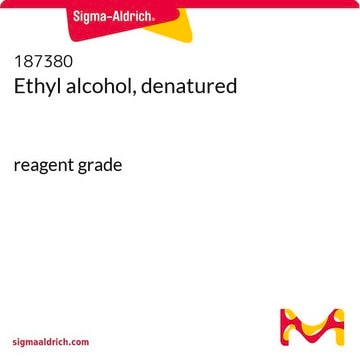245119
Reagent Alcohol
reagent, spectrophotometric grade, denatured, suitable for UV/Vis spectroscopy, contains 5% isopropyl alcohol and 5% methyl alcohol as denaturant
Synonym(s):
Ethanol, RGA, denatured alcohol
About This Item
Recommended Products
product name
Reagent Alcohol, spectrophotometric grade
grade
denatured
reagent
spectrophotometric grade
vapor density
1.59 (vs air)
form
liquid
contains
5% isopropyl alcohol as denaturant
5% methyl alcohol as denaturant
expl. lim.
3.1-27.7 %
technique(s)
UV/Vis spectroscopy: suitable
impurities
≤0.10% water
evapn. residue
<0.0005%
bp
78 °C
mp
-114 °C
density
0.785 g/mL at 25 °C
λ
H2O reference
UV absorption
λ: 205 nm Amax: 1.00
λ: 210 nm Amax: 0.65
λ: 220 nm Amax: 0.35
λ: 255 nm Amax: 0.04
λ: 300-400 nm Amax: 0.01
InChI
1S/C2H6O/c1-2-3/h3H,2H2,1H3
InChI key
LFQSCWFLJHTTHZ-UHFFFAOYSA-N
Looking for similar products? Visit Product Comparison Guide
Components
greener alternative product
Signal Word
Danger
Hazard Statements
Precautionary Statements
Hazard Classifications
Eye Irrit. 2 - Flam. Liq. 2 - STOT SE 2
Target Organs
Eyes,Central nervous system
Storage Class Code
3 - Flammable liquids
WGK
WGK 2
Flash Point(F)
48.2 °F - closed cup
Flash Point(C)
9 °C - closed cup
Regulatory Listings
Regulatory Listings are mainly provided for chemical products. Only limited information can be provided here for non-chemical products. No entry means none of the components are listed. It is the user’s obligation to ensure the safe and legal use of the product.
FSL
Group 4: Flammable liquids
Alcohols
Hazardous rank II
ISHL Indicated Name
Substances Subject to be Indicated Names
ISHL Notified Names
Substances Subject to be Notified Names
JAN Code
245119-2L:
245119-4X2L:
245119-BULK:
245119-1L:
245119-VAR:
245119-6X1L:
Certificates of Analysis (COA)
Search for Certificates of Analysis (COA) by entering the products Lot/Batch Number. Lot and Batch Numbers can be found on a product’s label following the words ‘Lot’ or ‘Batch’.
Already Own This Product?
Find documentation for the products that you have recently purchased in the Document Library.
Our team of scientists has experience in all areas of research including Life Science, Material Science, Chemical Synthesis, Chromatography, Analytical and many others.
Contact Technical Service







